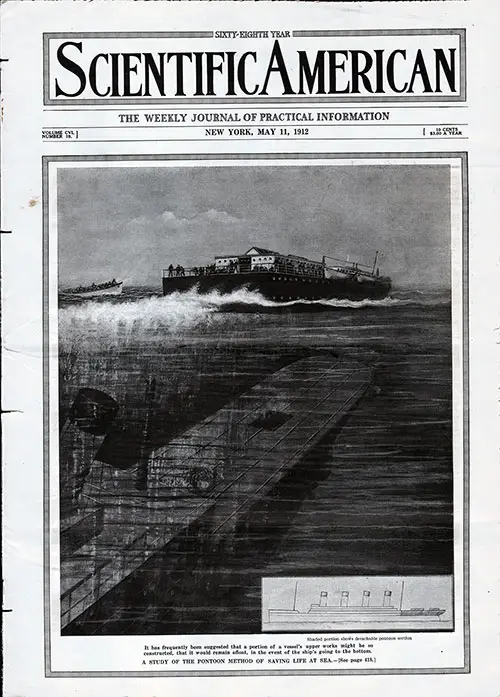Titanic - The Unsinkable Ship - Scientific American - 11 May 1912

Front Cover of the Scientific American for the 11 May 1912 Issue Featurnimg The Unkinkable Ship, TItanic. | GGA Image ID # 104af5c384
On the Front Cover: It has frequently been suggested that a portion of a vessel’s upper works might be so constructed, that it would remain afloat, in the event of the ship’s going to the bottom. Shaded portion in insert shows detachable pontoon section. A Study of the Pontoon Method of Saving Life at Sea.-[See page 418.]
Contents
News Briefs
- Why Expend $50,000,000 on Roads?
- The Compulsory License Question
- The "Great Eastern" and the "Titanic"
Electricity
- Chinese Students of Telephony
- Export of Electrical Apparatus
- Electric Smelting of Tin in Great Britain
- New English Gas-Electric Car
- Hot Water Supplied by an Electric Power Plant
- Improved Trancar Design
- Continuously Loaded Telephone Cable
- Electric Elevators for the Naples Subway
Science
- Bottled Gas for Home Use
- New Aerological Station in Germany
- Preserving the Tallest Trees in the World
- Sulphur as a Fertilizer
- A Book-Making Exposition
- Barometric Fluctguations in Subway Trains
- The Fate of Andree
Aeronautics
- A Record Flight from England to France With a Lady Passenger
- M. Blériot Visiting America
- American Passenger-Carrying Record
- An Aeroplane Fleet for Our Army
- Vedrines Hurt in Brussels-Madrid Race
- An Offer for a Cup Defender
Featured Articles
- A Safe Way of Storing Inflammable Liquids: The Martini and Huneke Apparatus
By Jacques Boyer
Safety apparatus for the handling of inflammable liquids should be simple in construction and automatic in operation, as a safeguard against carelessness or malicious interference on the part of employees or other persons, and every part of the installation should always be in condition for immediate use. The most practical method of securing these essential conditions consists in making the atmosphere above the liquid non-explosive by substituting an inert gas for air. This principle is adopted in the Martini and Huneke system, which is here described and illustrated, and which is employed extensively in various countries. - The “Unsinkable ” Ship: Longitudinal Coal Bunkers and Higher Bulkheads Might Have Saved the “Titanic"
By J. Bernard Walker
A vessel is considered to be safe, even in the event of serions damage, if she is able to keep afloat with two adjoining compartments in free communication with the sea. The vessel must therefore have efficient transverse watertight bulkheads so spaced that when any two adjoining compartments are open to the sea, the uppermost watertight deck to which all the bulkheads extend is not brought nearer to the surface of the water than a certain prescribed margin. - Newly Discovered Paintigs at Pompeii: A Revelation of Ancient Art
By Prof. Dr. Paul Hartwig - Alligator Farming: An Interesting Occupation With Little Competition
By Charles Alma Byers
Departments
- Correspondence
- Suggestions for the Workshop: Ingenious Expedients of Resourceful Mechanics
- What Inventors Are Doing: Simple Patent Law; Patent Office News; and Inventions New and Interesting
- New Books
- Notes and Queries
Publication Information
- Title: Scientific American: The Weekly Journal of Practical Information
- Issue: Volume CVI, Number 19
- Publisher: Munn & Co., Incorporated, New York
- Date of Publication: 11 May 1912
